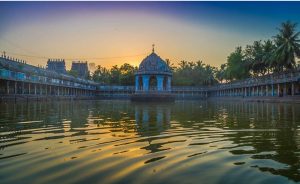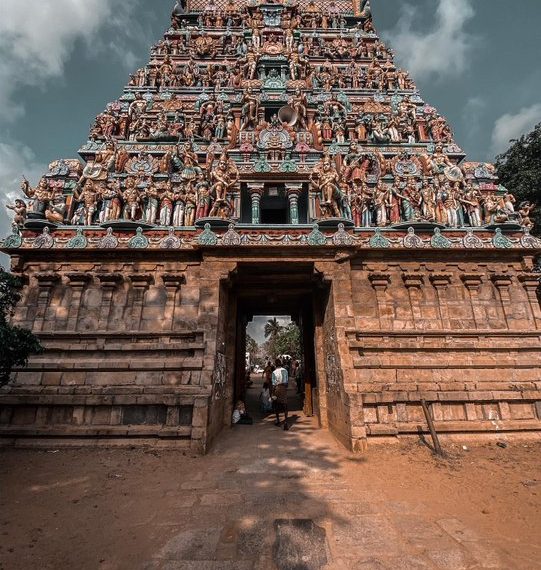
Vaitheeswaran Temple Deities
Vaitheeswaran Koil: Main Deity : Sri Vaidyanatha Swamy (Mahadev Shiva) Vaidya means Doctor,
Eswar means Mahadev Shiva
Consort: Sri Thaiyal Nayagi
Other Deities : Panchamoorthys, Muthukumaraswami (Lord Karthikeya), Angaraga (planet Mars/Mangal), Dhanvanthri, Jatayu, Badrakali, 63 Nayanmars.
Holy Water : SiddhamirthaTheertham
Sthala Vruksha : Neem (Vembu).

Dwaja Sthambam – Vaitheeswaran Temple
It is located 235 kilometers from Chennai, 27 km from Chidambaram, The holy waters of the Siddhamirtham tank within the mandir complex contains nectar, and a holy dip is believed to cure all diseases. The mandir is revered by the Tevaram hymns of 7th-century Saiva nayanars – Tamil sage poets and is also classified as a Paadam Petra Sthalam (Mandir revered by the nayanars).
During the Ramayana period, Sri Rama, Lakshmana and Saptarishi have worshiped the deity in this place.
According to Sattology Sri Rama and his brother Lakshmana cremated the vulture King Jatayu who was killed by Ravana when he tried to prevent the abduction of Sita at this place. There is a pond at this mandir called Jatayu kundam (pot of Jatayu having holy ash of Vibhuti).
One of the nine planets, Angaraka (Mars/Mangal), suffered from leprosy and was cured by Sri Vaidhyanathaswamy and from then on it is treated as one of the Navagraha Mandirs for planet Mars. Maa Parvati, the consort of Shiva, asked her son, Subrahmanya to appear with one face from his regular appearance of six faces. When he did so, she was pleased and presented him with Vel (a weapon) to slay the demons. Subrahmanya overcame the Asura Surapadman (a demon) & in the war, his army was severely injured. Shiva came out as the healer Vaitheeswaran and cured the wounds.

Lord Rama and Lakshmana with Jatayu
Like Panneer ilai Vibhuthi (Holy Ash) of Tiruchendur Mandir (Prasadam will be given in the leaf called Panneer here), The “Tiruchaandu Urundai” (called in Tamil) which is covered with Vibhuti of deity heals various incurable diseases. It can be procured at the Mandir.
The Mandir Architecture:
The Mandir has a 5-tier Gopuram large precincts
The central shrine is that of Sri Vaitheeswaran present as Lingam in the inner most sanctum. The first precinct around the sanctum has the metal image of Subrahmanya, worshiped here as Sri Muthukumara Swamy. The other metal images in the sanctum are of Nataraja, Somaskanda, Angaraka and stone sculptures of Durga, Dakshinamoorthy, Surya (Sun God), Jatayu, Vedas, Sampati (elder brother of Jatayu). The shrine of Maa Thaiyalnayaki who stands with the medicinal oil to cure the diseases of the devotees is present in the second precinct facing South.
The large precinct also has a small shrine to Dhanvantari and shrine of Angaraka in stone sculpture. The southern gateway from this precinct leads to the mandir pond and directly faces the Thaiyalnayaki shrine. The Sthala Vriksha (Mandir tree) is margosa (Azadirachta indica) which possesses medicinal properties. It is located in the Eastern gateway of the Mandir. The Eastern gateway also has the shrine of Adi (original) Mandir that has a smaller replica of the main shrines. There is a fine metal image of Gangavisarjanar inside the mandir.

Gopuram, Vaitheeswaran Temple
The mandir has five inscriptions mainly belonging to the period of Kulothunga Chola I (1070-1120 CE). The inscription on the steps of Subrahmanya shrine records the shutter of the sluice at Sattainathapuram measures 35 inches in length and 8 inches in breadth.
The one on the right of the Mandir pond indicates the tank, Nachiyar shrine, and its hall were completely renovated when Kanderayar was governing the Sigali Simai, and during the management of the mandir by Muthukumaraswami Tambiran, a disciple of Sivagnanadesikar- Sambandar of the Dharmapuram Adheenam. On the wall of the second precinct, the inscriptions state that the courtyard of Thayalnayagi shrine, the sacred steps and Tattisuri hall were built during Tamil year 4868 corresponding to 1689 CE. On the floor near accountant’s seat registers a deed granted by Sankarabaragiri Rengopanditar by Ambalavanatambiran, an agent of the Mandir. The Eastern gateway inscription indicates the gift of taxes from Manipallam in Tiruvalipparu.
Worship – Devotees take a holy dip in the Mandir pond before worshiping Sri Vaitheeswaran in the mandir. It is also a Sattology that dissolving jaggery in the waters cures skin diseases. The practice of jamming salt and pepper in front of the mandir mast and the pot near the mandir tank is also followed. Unlike other mandirs in South India, where each shrine has a Priest, each Priest in the Mandir associates themselves with the devotees and perform worship on their behalf. The Holy Soil rounded with ash (called Thiruchandu Urundai) is treated as medicine and believed to cure all the diseases. Another medicine given is chandan (sandalwood powder) with saffron. Devotees also donate carved silver plated body organs in the Hundi (vessel for offering) to cure the diseases.

Pond – Vaitheeswaran Temple

Naadi Jyotish – Vaitheeswaran Temple
Nadi Astrology (‘நாடி ஜோதிடம்’ in Tamil), (nāḍi jyotiṣa) is a form of Hindu Astrology practiced around the Mandir. It is based on the belief that the past, present and the future lives of all humans were foreseen by Hindu sages in ancient time.
The texts are mainly written in Vatteluttu, which is an ancient Tamil script. According to Sattology these were written by Sri Agasthya Maharishi who is said to have had divine revelations. These Nadi leaves were initially stored in the premises of Tanjore Saraswati Mahal Library of Tamil Nadu. The British rulers later showed interest in the Nadi leaves concerned with herbs and medicine and future prediction, but ironically left most of the leaves to their loyal people. Some leaves got destroyed and the remaining were auctioned during the British rule.

Agasthya Maharishi1
These leaves were obtained and possessed by the families of astrologers in Sri Vaitheeswaran Mandir and was passed down the years from one generation to the other.
The Mandir is revered by Tevaram hymns of sage poets Thirunavukkarasar and Sambandar belonging to the
7th century. The poets name the towns where they found the Mandir in their hymns and Pullirukkuvelur finds a mention in their verses, corresponding to the Mandir. The hymns appear to recognize the function of the mantras (sacred text) as invocation of Shiva. In addition the hymns from Thirunavukkarasar likes Shiva to luminous objects – a flame, a pearl, a diamond and pure gold. He also indicates wasting lot of days not worshiping Shiva at this mandir.
Location of the Temple from Google Maps
Om Namah Shivaaya Har Har Mahadev Shambho Shankara!!!
JAYA JAYA SHANKARA HARA HARA SHANKARA.
Images source: Google
A small video clip of the Mandir.
All information entered is personal to the author. Any modification or changes must be addressed to the author.







